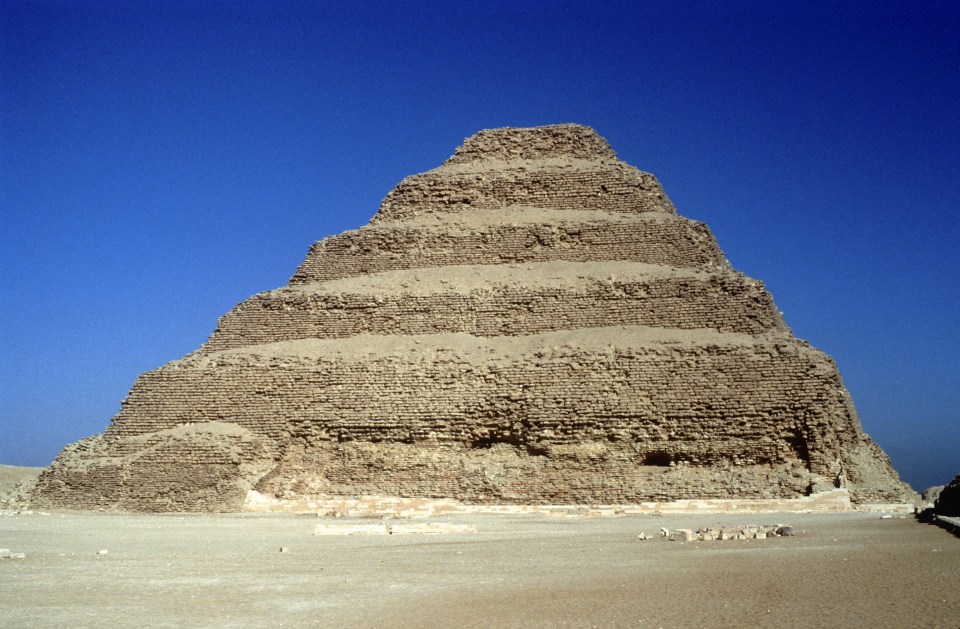
SCIENTISTS may have unlocked a key part of the mystery of how the Ancient Egyptians built the pyramids.
Groundbreaking new research suggested the structures - which date back some 4,500 years - were built using a lift powered by water.
The new study suggested that a complex network of channels were used to creat the sophisticated structures.
Egyptians would use what little water was available to float the enormous stones to the top of the pyramids.
Scientists dubbed this a "volcano" system.
Water would flow into a central shaft, lifting a raft carrying the stone until it reached the top - much like a tower block's lift or lava bubbling out of a volcano.
The new study theorising that water power was first published in Plos One.
It focused on the Step Pyramid of Djoser, constructed 4,500 years ago.
Clues in the structure and the surrounding area show the existence of this so-called " unified water-powered hydraulic lift system".
Previous theories of how the Step Pyramid came to be suggested that ancient Egyptians used a system of ramps and levers to give the pyramids their impressive height.
Most read in Tech
But the new idea suggests the pyramids’ architects made use of nearby canals for their construction, much like Egyptians of the time used the canals to irrigate their crops.
The researchers wrote: “Ancient Egyptians are famous for their pioneering and mastery of hydraulics through canals for irrigation purposes and barges to transport huge stones."
“This work opens a new line of research: the use of hydraulic force to erect the massive structures built by Pharaohs.”
The study argues that the ancient Egyptians used pressurized water to float the pyramid’s building stones toward the upper levels of the growing structure through an internal shaftway.
This process is known as “volcano” construction.
The researchers said they found evidence of a unified water filtration and hydraulic system at the Step Pyramid that purified water from nearby canals and regulated its flow for practical uses.
They believe the Step Pyramid may have been built downstream from a watershed.
And they think the nearby mysterious Gisr el-Mudir enclosure was a massive sediment trap featuring an open check dam.
The scientists claim they discovered the potential presence of a dried-up temporary lake west of the pyramid.
This likely filled up the “dry moat” encircling the pyramid complex, which then connected with a deep trench that brought water below the ground and up into the shaft inside the pyramid.
The report authors concluded: “We have uncovered a possible explanation for how the pyramids were built involving hydraulic force.”
“The internal architecture of the Step Pyramid is consistent with a hydraulic elevation device never reported before.”
World's biggest pyramids
- 1. Transamerica Pyramid – 260 metres (853 feet)
- 2. Great Pyramid of Giza – 138.5 metres (454 feet)
- 3. Pyramid of Khafre – 136.4 metres (448 feet)
- 4. Borobudur – 118 metres (387 ft)
- 5. Luxor Pyramid – 107 metres (350 ft)
- 6. Red Pyramid – 105 metres (344 ft)
- 7. Bent Pyramid – 104.7 metres (344 ft)
- 8. Memphis Pyramid – 98 metres (321 ft)
- 9. Toniná Pyramid – 74 metres (243 ft)
- 10. La Danta – 72 metres (236 ft)
The authors hope to conduct further research to understand in more detail how the possible water lift system worked.
It comes as researchers believe they may have solved the mystery of how the huge stones of Stonehenge were transported to the iconic structure.
It is claimed that the megaliths for Stonehenge, located near Amesbury, in Wiltshire, were moved from Welsh quarries using a "stone highway" - potentially explaining how they travelled from Wales to Salisbury Plain.
The journal Antiquity claims that the route initially thought to be true - proposed by H.H. Thomas in 192 - is wrong.
It reads: "New analytical techniques, alongside transmitted and reflected light microscopy, have recently prompted renewed scrutiny of Thomas's work.
Read More on The US Sun
"While respectable for its time, the results of these new analyses, combined with a thorough checking of the archived samples consulted by Thomas, reveal that key locations long believed to be sources for the Stonehenge bluestones can be discounted in favour of newly identified locations at Craig-Rhos-y-felin and Carn Goedog."
A study claims that the stones were moved from Pembrokeshire to Wiltshire on route using roads and rivers.













